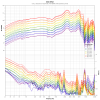It's true it lowers the useable volume pot range, on High Gain I don't use it past 9:30am on my harder to drive headphones. It does seem to sound cleaner, but it's so hard to compare these things accurately. If you look at the graph
View attachment 148292 the actual output of the majority of the music is gonna be around 50mVrms where you're talking about a difference between -87dB to -94dB. My K702 operates at worst case on the 3rd line up from the bottom on the following graph which is only 112mv, and that's related to peak RMS of the bass when EQ'd, so most of the music is below that and also after taking into account that tracks are not at 0dBFS the whole time:
View attachment 148289
So I'm theorising we can probably look at around the 50 mVrms section of the JDS Labs Atom distortion graph, which is where it's a difference between the -87dB to -94dB:
View attachment 148292
About the volume pot, it runs from around 7 o'clock to around 4 o'clock on the dial as it's max movement, which is about "9 hours" in total. If I run it at 9 o'clock that's about 22% of it's total travel and judging from Amir's following graph on channel mismatch vs volume pot position we can see it's only falling apart from 16 seconds through to the end of travel at 20 seconds:
View attachment 148293
That's the last 4 seconds of travel where it become unpredictable, which is the last 25%, which roughly equates to the first 25% of the volume dial.....so yes that equates up to about 9:30am on the volume dial as being the more unreliable area. So yeah, I might be giving up to about 0.5dB in channel balance accuracy by running High Gain. Marginal gains overall.....subjectively I seem to like High Gain better. EDIT: I normally use it Low Gain historically, just tried it in High Gain recently.
@amirm , is it possible the labels were accidentally swapped on the following graph, where it's showing higher distortion in Low Gain than High Gain?
View attachment 148292






